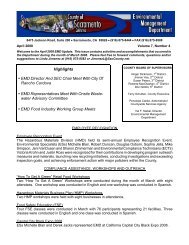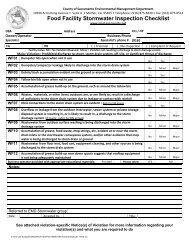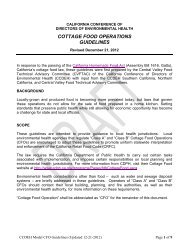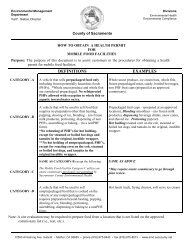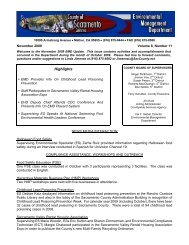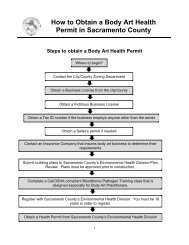California Water Well Standards, DWR Bulletin 74 ... - County of Glenn
California Water Well Standards, DWR Bulletin 74 ... - County of Glenn
California Water Well Standards, DWR Bulletin 74 ... - County of Glenn
- No tags were found...
You also want an ePaper? Increase the reach of your titles
YUMPU automatically turns print PDFs into web optimized ePapers that Google loves.
~ 1.Section 12. Casing.The term "casing" in its broadest sense includes all tubular materials that are permanent features <strong>of</strong> a well.Screens, collars, risers, liners, and blank casing in monitoring wells maintain the well bore and provide apassage for ground water level measurement and/or sample-collection devices.Protective casing serves to prevent accidental or intentional damage to a well. Protective casing normallyconsists <strong>of</strong> heavy gauge metallic pipe placed over the portion <strong>of</strong> the well casing that extends above groundsurface.Conductor casing usually functions as a temporary means <strong>of</strong> shoring the walls <strong>of</strong> a well boring to allow drillingand the placement <strong>of</strong> well construction materials. If used, temporary conductor casing is usually driven intoplace during drilling and is withdrawn at the same time filter pack and annular seal materials are installedaround the well casing. Sometimes conductor casing is left in place and is made a permanent feature <strong>of</strong> thecompleted well structure. Requirements for sealing permanent conductor casing in place are contained inSection 9.For the purpose <strong>of</strong> these standards, the term "casing" applies to screens, collars, risers, and blank casing, andother specialized products used to maintain the well bore. General discussion and standards for casingmaterials are contained in Section 12 <strong>of</strong> the <strong>Water</strong> <strong>Well</strong> <strong>Standards</strong>. Special considerations that apply tomonitoring well casing are described below:ACasinl! Material.Chemical ComRatibility. Special consideration shall be given to the selection <strong>of</strong> casingmaterials for monitoring wells installed in environments that are chemically "hostile".The selected casing shall resist chemical attack and corrosion.Special consideration should be given to the selection <strong>of</strong> casing materials for wells tobe used for sensitive water-quality determinations. Chemical interaction between casingmaterials and pollutants, contaminants, ground water, filter pack material, and geologicmaterials could bias ground-water quality determinations.2. Used Casing. Used casing may be acceptable in certain cases, at the approval <strong>of</strong> theenforcing agency.3. Plastic and Steel Casing. Plastic and steel well casing materials are commonly used formonitoring wells. The principal plastics used for water-quality monitoring wells arethermoplastics and fluorocarbon resins.<strong>Standards</strong> for thermoplastic well casing are in Section 12 <strong>of</strong> the <strong>Water</strong> <strong>Well</strong> <strong>Standards</strong>.The principal thermoplastic material used for water quality monitoring wells is polyvinylchloride (PVC).Fluorocarbon casing materials include fluorinated ethylene propylene (FEP) andpolytetrafluoroethylene (PTFE). Fluorocarbon resin casing materials are generallyconsidered immune to chemical attack. Fluorocarbon casing materials shall meet thefollowing specifications, including the latest revisions there<strong>of</strong>:a. ASTM D3296, Standard Specification for FEP-FLuorocarbon Tube.b. ASTM D3295, Standard Specifications for PTFE Tubing.-47-



